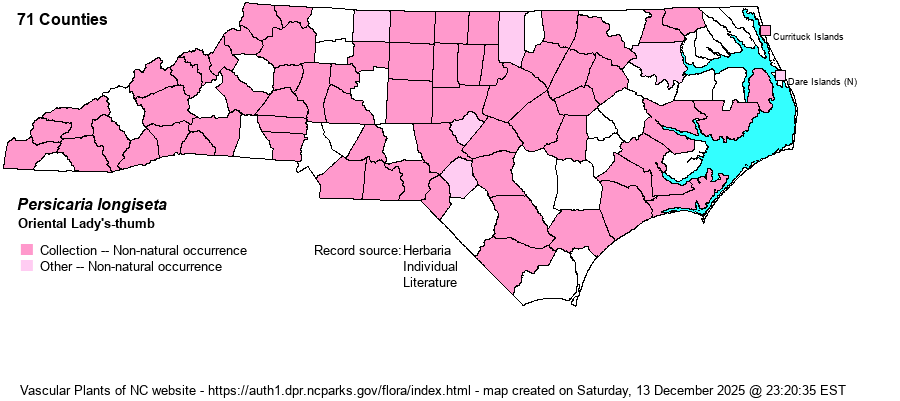| Author | (de Bruijn) Kitagawa | |
| Distribution | Throughout the state; sure to be found in additional counties. First collected in 1937 at the shore of Lake Waccamaw, Columbus County, by H.J. Oosting.
Native of eastern Asia; in N.A. -- N.B. to Ont. and MN, south to FL and TX; also B.C. | |
| Abundance | Frequent to common throughout, except rare on the Outer Banks. We believe it to be actively spreading. | |
| Habitat | Moist to wet roadside ditches, margins of swamp forests, floodplain forests, river and stream shores, wet cropfields, lake and impoundment shores, lawn weed, campus weed. |
| Phenology | Flowering and fruiting May-October. | |
| Identification | Oriental Lady's-thumb is superficially like some other Persicaria species, but note the prostrate to ascending (not erect) stems, the relatively short leaves, and the very slender pink inflorescences. The collar on the stem at the base of the leafstalk has bristles 4-12 mm long (vs. less than 5 mm long in P. maculosa). Also, that common alien species has a broader inflorescence (6-12 mm thick vs. 3-6 mm thick) and usually has leaves with a dark spot in the middle, whereas P. longiseta has unblotched leaves. | |
| Taxonomic Comments | Named as Polygonum cespitosum var. longisetum in RAB (1968).
Many species formerly treated in the genus Polygonum have been moved to Persicaria, the smartweeds. These are generally erect and tall plants with terminal and axillary floral spikes; most occur in wetlands. Others remain in Polygonum, the knotweeds, which are generally prostrate to ascending and with inconspicuous axillary flowers. They occur mostly in dry soils and tend to be weedy.
Attention must be paid to the small collars at the junction of the main stem and leaf stems (called ocreae) and whether they possess terminal hairs or bristles. Some keys also refer to the even smaller collars from which flowers emerge (called ocreolae). Another important ID character is the surface of the greenish sepals -- whether smooth or dotted with indentations (punctate). | |
| Other Common Name(s) | | |
| State Rank | SE | |
| Global Rank | GNR | |
| State Status | | |
| US Status | | |
| USACE-agcp | FAC link |
| USACE-emp | FAC link |

